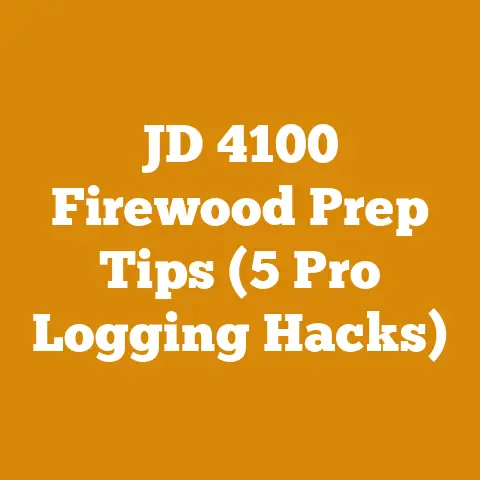Average Firewood Length (5 Expert Tips for Precise Cuts)
Do you remember the satisfying crackle of a perfectly sized log in the fireplace on a cold winter’s night?
Or perhaps the focused precision of cutting wood for a woodworking project?
Getting the firewood length just right is crucial for both efficiency and enjoyment.
This article will dive deep into the art and science of achieving that perfect firewood length, along with practical advice, cost considerations, and expert tips to guide you.
Average Firewood Length: 5 Expert Tips for Precise Cuts
Finding the “average” firewood length is like trying to nail down the average height of a tree.
It depends!
But don’t worry; I’m here to help you navigate the woodpile.
Having spent years splitting, stacking, and burning firewood (not to mention a fair bit of woodworking), I’ve learned a thing or two about what works best, what saves money, and what makes your life easier.
Understanding the Ideal Firewood Length
The “ideal” firewood length is subjective, varying based on several factors:
- Fireplace or Stove Size: This is the most crucial factor.
You need firewood that fits comfortably inside your firebox without being too long to maneuver or too short to burn efficiently. - Wood Species: Some woods burn hotter and longer than others.
Denser hardwoods like oak or hickory can be cut slightly longer than softer woods like pine or poplar. - Personal Preference: Some folks prefer shorter pieces for easier handling, while others want longer pieces for extended burn times.
So, what’s the average?
Generally, 16 inches is considered a standard firewood length.
This length is often recommended because it fits in most common fireplaces and wood stoves.
However, this is just a starting point.
Data Point: According to the Hearth, Patio & Barbecue Association (HPBA), the most common firebox size in North American homes falls within the range that accommodates 16-inch firewood.
Expert Tip #1: Measure Your Firebox
Before you even think about picking up a chainsaw, measure the inside of your fireplace or wood stove.
I cannot stress this enough.
You want the internal dimensions, not the external ones.
Measure the width, depth, and height of the firebox.
Your firewood should be at least 2-3 inches shorter than the shortest of these measurements.
Personal Experience: I once spent an entire afternoon splitting wood to what I thought was the right size, only to discover it was too long for my new wood stove.
A frustrating waste of time and energy!
Learn from my mistake.
Calculation: Let’s say your firebox is 20 inches wide, 18 inches deep, and 15 inches high.
Your ideal firewood length should be no more than 12-13 inches.
Expert Tip #2: Consider Wood Species and Burn Rate
Different wood species have different burn rates and heat outputs.
Hardwoods like oak, maple, and ash burn longer and hotter than softwoods like pine, fir, and cedar.
- Hardwoods: Can be cut slightly longer because they burn slower.
A 16-inch piece of oak will burn longer than a 16-inch piece of pine. - Softwoods: Best cut shorter to prevent them from burning too quickly and creating excessive smoke.
Data Point: The BTU (British Thermal Unit) content of firewood varies significantly by species.
Oak can have a BTU rating of around 28 million per cord, while pine might be closer to 20 million.
Practical Example: If you’re burning mostly oak, you might be comfortable with 16-inch pieces.
But if you’re burning pine, consider cutting your firewood to 12-14 inches for better control and less smoke.
Expert Tip #3: The “Thumb Rule” Method
For quick and dirty estimations, I often use the “thumb rule.” This isn’t a scientific method, but it’s surprisingly effective in the field.
- Hold your thumb out at arm’s length.
- The length from the tip of your thumb to the first knuckle is roughly an inch.
- Use your hand to estimate the desired firewood length.
For example, 16 inches is about the length of two hands placed side-by-side (minus a few inches).
This method is great for making adjustments on the fly while you’re splitting wood.
Expert Tip #4: Creating a Cutting Jig
For consistent and accurate cuts, a cutting jig is your best friend.
A cutting jig is a simple device that helps you measure and cut firewood to the same length every time.
How to Build a Cutting Jig:
- Materials: You’ll need some scrap wood (2x4s work well), a saw, screws or nails, and a measuring tape.
- Construction: Cut two pieces of wood to the desired firewood length (e.g., 16 inches).
Attach these pieces to a base, creating a “U” shape. - Usage: Place the log inside the jig and cut along the open end.
This ensures that every piece of firewood is the same length.
Personal Story: I built my first cutting jig out of sheer frustration.
I was tired of constantly measuring and re-measuring each piece of wood.
The jig saved me hours of work and improved the consistency of my firewood.
Expert Tip #5: Safety First!
No matter how experienced you are, safety should always be your top priority when handling a chainsaw or splitting wood.
- Wear appropriate safety gear: This includes safety glasses, hearing protection, gloves, and sturdy boots.
- Maintain your equipment: Keep your chainsaw sharp and in good working order.
A dull chainsaw is a dangerous chainsaw. - Be aware of your surroundings: Make sure you have a clear and stable work area.
- Never rush: Take your time and focus on what you’re doing.
Important Note: If you’re not comfortable using a chainsaw, consider taking a chainsaw safety course.
It’s a worthwhile investment that could save you from serious injury.
The Cost of Firewood Preparation: A Deep Dive
Now, let’s talk about the money.
Preparing firewood isn’t just about sweat and sawdust; it’s also about budgeting and cost management.
I’ll break down the various cost components and provide tips for optimizing your expenses.
Variable Factors Affecting Project Costs
Before we get into the numbers, it’s crucial to acknowledge the variable factors that can affect your firewood preparation costs:
- Wood Type: Different wood species have different prices.
Hardwoods are generally more expensive than softwoods. - Location Accessibility: If you have to travel far to obtain your wood, transportation costs will increase.
- Seasonality: Firewood prices tend to be higher in the fall and winter when demand is highest.
- Equipment Ownership vs.
Rental: Owning your own chainsaw and splitter can be more cost-effective in the long run, but it requires a significant upfront investment. - Labor: Are you doing all the work yourself, or are you hiring help?
Labor costs can be a significant expense.
Cost Component Breakdown
Let’s break down the cost components of firewood preparation:
- Timber Purchase or Harvesting Costs:
- Purchasing Wood: The cost of buying firewood varies depending on the species, quantity, and location.
You can buy firewood by the cord, face cord, or rick.- Data Point: According to the U.S.
Energy Information Administration (EIA), the average price per cord of seasoned hardwood firewood in the United States ranges from \$200 to \$400, depending on location and species.
- Data Point: According to the U.S.
- Harvesting Your Own Wood: If you have access to land where you can harvest your own wood, you’ll save on the purchase price.
However, you’ll still need to factor in the cost of permits, transportation, and equipment.- Permits: Some areas require permits for cutting down trees, even on private property.
Check with your local authorities to determine if you need a permit and how much it costs. - Transportation: You’ll need a truck or trailer to transport the wood.
Factor in the cost of fuel and vehicle maintenance.
- Permits: Some areas require permits for cutting down trees, even on private property.
- Purchasing Wood: The cost of buying firewood varies depending on the species, quantity, and location.
- Tool Costs:
- Chainsaw: A good quality chainsaw is essential for cutting firewood.
The cost of a chainsaw can range from \$200 for a basic model to \$1,000 or more for a professional-grade saw.- Maintenance: Chainsaws require regular maintenance, including sharpening the chain, cleaning the air filter, and replacing spark plugs.
Factor in the cost of these maintenance items.
- Maintenance: Chainsaws require regular maintenance, including sharpening the chain, cleaning the air filter, and replacing spark plugs.
- Wood Splitter: A wood splitter can save you a lot of time and energy, especially if you’re splitting a large amount of wood.
Wood splitters can be manual (hydraulic) or powered (gas or electric).- Manual Splitter: Costs range from \$100-\$300
- Powered Splitter: Costs range from \$1,000 – \$3,000
- Rental: Renting a splitter can be a cost-effective option if you only need it for a short period.
Rental fees typically range from \$50 to \$100 per day.
- Other Tools: You’ll also need other tools, such as an axe, sledgehammer, wedges, and measuring tape.
- Chainsaw: A good quality chainsaw is essential for cutting firewood.
- Labor Wages:
- DIY: If you’re doing all the work yourself, your labor is “free” (except for the value of your time).
- Hiring Help: If you’re hiring help, you’ll need to pay them an hourly wage.
Labor costs can vary depending on the location and the experience of the workers.
- Permits (If Applicable):
- As mentioned earlier, some areas require permits for cutting down trees.
The cost of these permits can vary depending on the location and the type of tree.
- As mentioned earlier, some areas require permits for cutting down trees.
- Fuel and Oil:
- Chainsaw Fuel: Chainsaws require a mixture of gasoline and oil.
The cost of fuel and oil can add up over time. - Splitter Fuel: Gas-powered wood splitters also require fuel.
- Chainsaw Fuel: Chainsaws require a mixture of gasoline and oil.
- Safety Gear:
- Safety glasses, hearing protection, gloves, and sturdy boots are essential for safe firewood preparation.
The cost of safety gear can range from \$50 to \$100.
- Safety glasses, hearing protection, gloves, and sturdy boots are essential for safe firewood preparation.
- Storage:
- You’ll need a dry place to store your firewood.
If you don’t have a shed or garage, you may need to build or purchase a firewood rack.
- You’ll need a dry place to store your firewood.
Current Industry Benchmarks and Statistical Data
Here are some current industry benchmarks and statistical data related to firewood preparation:
- Average Price per Cord of Firewood: As mentioned earlier, the average price per cord of seasoned hardwood firewood in the United States ranges from \$200 to \$400.
- Equipment Rental Fees: Chainsaw rental fees typically range from \$30 to \$50 per day, while wood splitter rental fees range from \$50 to \$100 per day.
- Labor Costs: Labor costs for firewood preparation can vary depending on the location and the experience of the workers.
Expect to pay anywhere from \$15 to \$30 per hour.
Source: U.S.
Energy Information Administration (EIA), Hearth, Patio & Barbecue Association (HPBA), Local Equipment Rental Companies
Practical Tips for Cost Optimization and Budget Management
Here are some practical tips for cost optimization and budget management in firewood preparation projects:
- Buy Wood in Bulk: Buying firewood in bulk can save you money.
Look for suppliers who offer discounts for large orders. - Harvest Your Own Wood (If Possible): If you have access to land where you can harvest your own wood, you’ll save on the purchase price.
- Rent Equipment Instead of Buying: If you only need a chainsaw or wood splitter for a short period, renting can be more cost-effective than buying.
- Maintain Your Equipment: Regular maintenance can extend the life of your equipment and prevent costly repairs.
- Shop Around for the Best Prices: Compare prices from different suppliers and rental companies to find the best deals.
- Season Your Firewood Properly: Properly seasoned firewood burns more efficiently, which means you’ll need less of it.
- Do It Yourself (If Possible): Doing the work yourself can save you money on labor costs.
- Consider Alternative Fuel Sources: If firewood prices are too high, consider alternative fuel sources, such as propane or natural gas.
Relevant Calculations and Formulas
Here are some relevant calculations and formulas that can help you estimate your firewood needs and costs:
- Estimating Firewood Needs:
- To estimate how much firewood you’ll need for the winter, consider the size of your home, the efficiency of your wood stove, and the severity of the winter.
- A general rule of thumb is that a well-insulated home in a moderate climate will require about 3-4 cords of firewood per winter.
- Calculating Volume of Logs in Board Feet or Cords:
- Board Feet: A board foot is a unit of measurement for lumber that is 1 inch thick, 12 inches wide, and 12 inches long.
- Cord: A cord is a unit of measurement for firewood that is 4 feet high, 4 feet wide, and 8 feet long (128 cubic feet).
- There are various formulas for calculating the volume of logs in board feet or cords.
These formulas take into account the diameter and length of the logs.
- Estimating Drying Time Based on Moisture Content:
- Freshly cut wood can have a moisture content of 50% or higher.
Firewood needs to be seasoned (dried) to a moisture content of 20% or less for efficient burning. - The drying time for firewood depends on the species of wood, the climate, and the storage conditions.
Generally, it takes at least 6-12 months for firewood to dry properly. - You can use a moisture meter to measure the moisture content of your firewood.
- Freshly cut wood can have a moisture content of 50% or higher.
Formula for Calculating Volume of a Log (Doyle Log Scale):
Board Feet = (Small End Diameter in Inches – 4) * (Small End Diameter in Inches – 4) * (Length in Feet / 16)
Example:
A log with a small end diameter of 12 inches and a length of 16 feet would have a volume of:
(12 – 4) * (12 – 4) * (16 / 16) = 64 board feet
Formula for Calculating Drying Time:
Drying Time (Months) = k * (Initial Moisture Content – Target Moisture Content)
Where ‘k’ is a constant that depends on the climate and wood species.
Case Study: Budgeting for Firewood Preparation
Let’s consider a case study of a homeowner who wants to prepare 4 cords of firewood for the winter.
Assumptions:
- The homeowner has access to land where they can harvest their own wood.
- They already own a chainsaw but need to rent a wood splitter.
- They will do all the work themselves.
- The cost of a permit is \$50.
- The rental fee for a wood splitter is \$75 per day.
- The cost of fuel and oil is \$50.
- The cost of safety gear is \$75.
Cost Breakdown:
- Permit: \$50
- Wood Splitter Rental (2 days): \$150
- Fuel and Oil: \$50
- Safety Gear: \$75
- Total Cost: \$325
In this case, the homeowner can prepare 4 cords of firewood for a total cost of \$325.
This is significantly less than the cost of buying 4 cords of firewood, which could range from \$800 to \$1600.
Addressing the Challenges Faced by Small-Scale Loggers and Firewood Suppliers
Small-scale loggers and firewood suppliers face several challenges, including:
- Fluctuating Timber Prices: Timber prices can fluctuate significantly, making it difficult to plan and budget.
- Competition from Larger Companies: Small-scale loggers and firewood suppliers often face competition from larger companies that can offer lower prices.
- Regulatory Compliance: Complying with environmental regulations can be costly and time-consuming.
- Equipment Costs: Maintaining and replacing equipment can be a significant expense.
To overcome these challenges, small-scale loggers and firewood suppliers need to:
- Develop a Strong Business Plan: A well-developed business plan can help them identify their target market, set prices, and manage costs.
- Focus on Quality: Providing high-quality firewood can help them differentiate themselves from the competition.
- Build Relationships with Customers: Building strong relationships with customers can help them retain business and generate referrals.
- Explore Niche Markets: Consider specializing in a particular type of firewood or offering value-added services, such as delivery and stacking.
- Collaborate with Other Businesses: Collaborating with other businesses can help them share resources and reduce costs.
Actionable Takeaways and Next Steps
Preparing firewood can be a rewarding and cost-effective way to heat your home or enjoy a cozy fire.
By following these expert tips and carefully managing your costs, you can achieve the perfect firewood length and save money in the process.
Here are some actionable takeaways and next steps for readers planning wood processing or firewood projects:
- Measure Your Firebox: Determine the ideal firewood length for your fireplace or wood stove.
- Consider Wood Species and Burn Rate: Choose the right wood species for your needs and adjust the firewood length accordingly.
- Build a Cutting Jig: Create a cutting jig to ensure consistent and accurate cuts.
- Prioritize Safety: Wear appropriate safety gear and maintain your equipment.
- Develop a Budget: Estimate your firewood needs and costs, and create a budget to stay on track.
- Shop Around for the Best Prices: Compare prices from different suppliers and rental companies.
- Season Your Firewood Properly: Allow your firewood to dry for at least 6-12 months before burning it.
- Stay Informed: Keep up-to-date on industry trends, regulations, and best practices.
Remember, firewood preparation is a journey, not a destination.
Be patient, learn from your mistakes, and enjoy the process.
And most importantly, stay safe and have fun!
With a little bit of planning and effort, you can enjoy the warmth and beauty of a crackling fire all winter long.
From my experiences, the warmth from the wood you’ve prepared yourself is just that much cozier.






